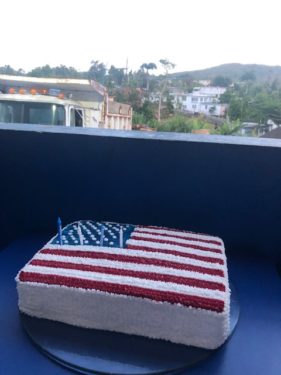
When celebrating America as an independent nation in the U.S., one can be certain that a few staple events will occur: highways will be piled with cars escaping to the beach, the smell of barbecue will fill the air and the sound of popping fireworks will be heard throughout the day. In the mountains of Puerto Rico, while separated from the mainland by twice the length of Florida in distance, the U.S. territory is somewhat tranquil on July 4.
Nearly two years after Hurricane Maria devastated the island, fireworks are far and in between, the smell of grilled meat fills the air, tropical fruits are being sold along the highway and ever so often locals are seen wearing bright t-shirts with the huge letters U-S-A or the flag displayed on them.
Cultural Exchange
In Aibonito, July 4 falls during the town’s 51st annual Festival de los Flores, or festival of flowers. The 30-plus group from Brooklyn and Queens attended the annual celebration. A local band played Bon Jovi in the background as the festival took full flight. For the group visiting from New York, the day reflected familiar street festivals back home. When they found items they wanted to purchase from a local vendor, U.S. dollars and coins exchanged hands in between a hello and a “gracias” greeting in Spanish.
But for some local Puerto Ricans, the road back to celebrating a normal livelihood is still yet to be seen. One neighborhood saw four homes destroyed within walking distance from each other.
“Maria destroyed everything, so they’ve been working on this for a while,” Marilyn Santos explained. She was translating for the diocesan contingent and accompanied them as a representative of the Secretariat of Evangelization and Catechesis of the United States Conference of Catholic Bishops.
“They’ve obviously done a lot, but it’s only been within the last two months that they’ve been able to get what they needed.”
Despite the lapse in relief efforts, Aibonito was one of the towns that received expedited assistance during Hurricane Maria. According to Evelio Santiago, the director of social ministries at St. Joseph’s Parish, a church in Aibonito of the Diocese of Caguas, the town’s mayor, William Alicia Perez, first decided to empty and clear their town’s streets so that relief could reach the rural town.
Santiago added that FEMA provided his parish with vouchers to local groceries, but assistance from the international arm of Catholic Charities, Caritas Puerto Rico, was sparse. He said most of the help came from the local community, surrounding communities, as well as assistance from local organizations based in New Jersey and Chicago.
Government Assistance
In the town of Argenal, the Federal Emergency Management Agency (FEMA) provided assistance for Amerelis Gonzalez and her family of four, including two young boys under the age of four. But FEMA decided that only the inside of her former house qualified for the monetary assistance. That’s because her house was made mostly of wood. So while her family tries to rebuild their house on concrete this time, they have been living for months out of a couple suitcases surrounded by the bricks of concrete that is yet to be covered by a roof. Amerelis said she is still thankful that her family is safe and together.
For one retired couple that grew up in the Diocese of Brooklyn but now live in Aibonito’s Rabanal semi-urban community, they said they celebrate the July 4 holiday when they are in the mainland, but not necessarily when on the island.
Whether it was the army soldiers who visited her community by helicopter and dropped boxes of bottled water to a nearby park, or FEMA who offered a loan to help offset the hurricane’s damage to their home that they couldn’t see for months because of the island’s condition, Maria said the U.S. helped the island and continues to help the people of Puerto Rico.
“God is good,” said the former Our Lady of Mercy- Our Lady of the Presentation, Brownsville, parishioner. Inside the couple’s home is a picture that lights up and displays the Twin Towers. Nearly two years ago, their home was filled with mold because of the devastation. They said what while they learned a huge lesson after the natural disaster, that their faith has carried them through.
“We were so scared, but the third day my husband came with my son and saw the house. And when they got back, I started to cry, because they said the house was still standing. It was such a blessing.”
Flavor of the Fourth
In the evening, the diocesan ambassadors and their co-partners in the mission trip, the parishioners from St. Joseph parish, gathered for a fusion celebration of the American holiday: hamburgers were served alongside plates of arroz con pollo and plantains, or rice and beans. The concrete dance floor transformed into the hub where salsa music played in between line dances like the “Cha-Cha” slide. Regardless of language differences or cultural backgrounds, whether their home was Brooklyn or the local barrio, they danced together to the boom-bap of the drums and the blurred words, English and Spanish alike.
























